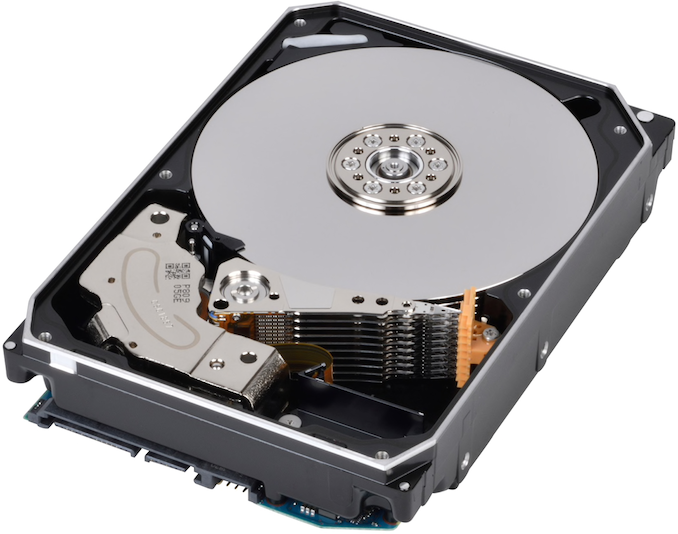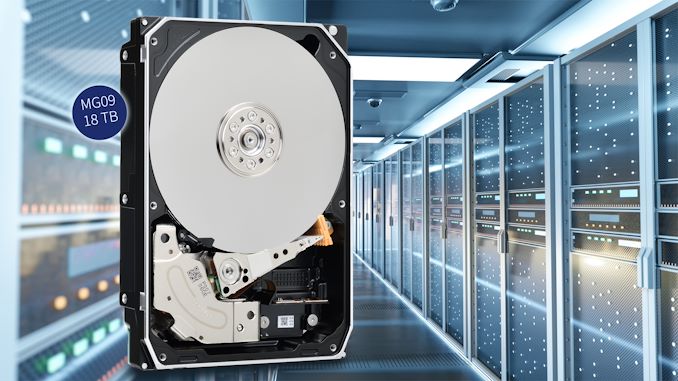Toshiba Unveils World's First FC-MAMR HDD: 18 TB, Helium Filled
by Anton Shilov on February 19, 2021 9:50 AM EST- Posted in
- Storage
- Toshiba
- HDDs
- MAMR
- Helium HDD
- Showa Denko
- MG09

Toshiba this week announced the industry's first hard drive featuring flux-control microwave-assisted magnetic recording (FC-MAMR) technology. The new MG09-series HDDs are designed primarily for nearline and enterprise applications, they offer an 18 TB capacity along with an ultra-low idle power consumption.
The Toshiba MG09-series 3.5-inch 18 TB HDD are based on the company's 3rd generation nine-platter helium sealed platform that features 18 heads with a microwave-emitting component which changes magnetic coercivity of the platters before writing data. The HD disks are made by Showa Denko K.K. (SDK), a long-time partner of Toshiba. Each aluminum platter is about 0.635 mm thick, it features an areal density of around 1.5 Tb/inch2 and can store up to 2 TB of data. The MG09 family also includes a 16 TB model which presumably features a lower number of platters (based on the same performance rating).
For modern enterprise and nearline 3.5-inch HDDs, Toshiba's MG09-series drives uses a motor with a 7200-RPM spindle speed. The HDDs are also equipped with a 512 MB buffer and are rated for a 281 MB/s maximum sustained data transfer rate. Unfortunately, Toshiba has not updated the random access performance of the new products, though it is likely that their per-TB IOPS performance is lower when compared to predecessors. The manufacturer will offer its new drives both with SATA 3.3 (6 Gbps) and SAS 3.0 (12 Gbps) interfaces as well as a selection of logical data block length.
One of the noteworthy things about Toshiba's MG09-series FC-MAMR HDDs is their power consumption. In active idle mode, they typically consume 4.16/4.54 Watts (SATA/SAS models), which is considerably lower when compared with Seagate's Exos X18 as well as Western Digital's Ultrastar DC HC550. As far as power consumption efficiency at idle (large hard drives could spend plenty of time idling) is concerned, the 18 TB MG09 is an undeniable champion consuming just 0.23 Watts per TB (in case of the SATA version). Meanwhile, the new drives are rated for 8.35/8.74 Watts (SATA/SAS SKUs) during read/write operations, which is higher when compared to the DC HC550 as well as predecessors from the MG07 and the MG08-series.
| Brief Specifications of Toshiba's MG09 HDDs | |||||
| Capacity | 18 TB | 16 TB | |||
| Platters | 9 | 8 | |||
| Heads | 18 | 16 | |||
| Recording Technology | Flux-control microwave-assisted magnetic recording (FC-MAMR) |
||||
| RPM | 7200 RPM | ||||
| Interface | SATA 6 Gbps/SAS 12 Gbps | ||||
| DRAM Cache | 512 MB | ||||
| Persistent Write Cache | Yes | ||||
| Helium-Filling | Yes | ||||
| Sequential Data Transfer Rate (host to/from drive) | 281 MB/s | ||||
| MTBF | 2.5 million | ||||
| Rated Annual Workload | 550 TB | ||||
| Acoustics (idle) | 20 dB | ||||
| Power Consumption | Random read/write | SATA: 8.35 W SAS: 8.74 W |
|||
| Idle | SATA: 4.16 W SAS: 4.54 W |
||||
| Warranty | 5 Years | ||||
As the MG09 family of hard drives are intended for datacenter racks that accommodate hundreds of vibrating HDDs, they feature numerous enhancements to ensure consistent performance, reliability, and durability. Typically such enhancements include top and bottom attached motors, RVFF, as well as environmental sensors. Like all modern drives for 24/7 applications, Toshiba's MG09-series units are rated for a 550 TB average annualized workload, 2.5 million hours MTBF, and are covered with a standard five-year warranty.
Also, the new MG09 hard drives support Toshiba’s persistent write cache (PWC) with power loss protection (PLP) technology, which is crucial for 4K sector drives that emulate 512B sectors. The PWC with PLP feature guards data in case of power loss while performing read-modify-write (RMW) operation to align the source write request with the physical sectors it has to modify. This capability allows the company to address its clients who run legacy systems that still require high capacities. Also, the new MG09 family includes Sanitize Instant Erase (SIE) and Self Encrypting Drive (SED) models.
Toshiba has been working on its MG09-series FC-MAMR HDDs for at least two years already. Last year the company said it had made 'significant investments in manufacturing facilities' and promised to start shipments of its 18 TB hard drives by March 31, 2021. This week the company reaffirmed its plan and said it would begin sample shipments of its 18 TB MG09-series MAMR HDDs 'at the end of March 2021.'
Source: Toshiba











23 Comments
View All Comments
Tomatotech - Friday, February 19, 2021 - link
550 TB annualised is 1.5TB per day. At max transfer that’s almost 2 hours at full speed which they are unlikely to see after the initial filling up. I’d guess Toshiba knows very well the usage patterns for drives like these and that they are unlikely to see 1.5TB transfer every day for a whole year.Danvelopment - Saturday, February 20, 2021 - link
Lol, what kind of environment are you in where putting more than 1.5TB of fresh new data every day on a single drive is a real scenario? Where, 13 days later, you're also deleting 1.5TB every day from one drive?Be sure not to confuse my question with, "Adding a fresh 1.5TB of data per day".
The difference is dealing with 1.5TB fresh data per day vs 1.5TB of fresh data per day on a single drive.
If you're ever in a scenario where you're putting 1.5TB of data per day on any single drive within the next 5 years, you probably need to revisit your infrastructure planning because there are major gaping flaws in it.
Wereweeb - Saturday, February 20, 2021 - link
I think this is making fun of people who complain about QLC endurance.Spunjji - Monday, February 22, 2021 - link
I hope so, but Poe's Law hits hard!Samus - Monday, February 22, 2021 - link
These are WORM-style enterprise drives that will likely find themselves in 'cold-storage' scenarios at data centers. Even in the event they are in intense workload applications, software will load balance writes among multiple arrays in a SAN container according to the defined design profile of the hardware. 1.5m MTBF and ~.1 DWPD seems pretty average for enterprise SATA-class drives.Tomatotech - Friday, February 19, 2021 - link
18TB capacity. 9 platters, 18 sides. 2 TB per platter, 1 TB per side. Areal density of “about 1.5TB/inch^2”.That means each platter side has about 0.66 square inches of usable space. Seems very low for a 3.5 inch diameter platter, or am I missing something?
If my calculations are right, that means the total usable area is a ring on the platter only around 6mm wide.
popopow - Friday, February 19, 2021 - link
Tb != TBback2future - Saturday, February 20, 2021 - link
theoretical accessible platter area ~15"², 11"² * 9 ~18TBTomatotech - Saturday, February 20, 2021 - link
Oops brain fart. I’ll quietly hand in my geek card and go out the back door. Thanks for pointing out my mistake.back2future - Saturday, February 20, 2021 - link
Maybe reading this, https://en.wikipedia.org/wiki/Patterned_media#Comp... shows that pointing to areal density was very worth thinking more deeply about ( https://en.wikipedia.org/wiki/Areal_density_(compu... ). So Your estimation is pretty much within possible areal densities (BPM?) or maybe what shingled write patterns (WD only?, SMR ~10Tb/"² ) can store on hdds. HAMR (MAMR?) plans on ~80TB for 3.5" ( https://www.anandtech.com/show/15484/the-road-to-8... ).